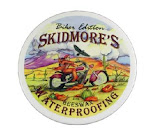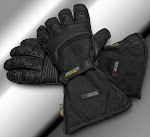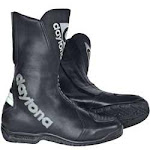Tuesday
Care and Repair of Motorcycle Leatherwork
This is a basic common sense guide to 'leather fettling' for ordinary bikers, written with the backing of more than thirty years experience and is offered without any guarantees - either implied or explicit!
Note: You won't need expensive cleaning chemicals, fancy waxes or polishing potions and you won't need to work too hard either. Everything on this page is about the easiest and cheapest way to keep your stuff looking good and working well.
Looking after motorcycle leathers
Rule 1: If you want your motorcycle leathers to last a long time then you have to take good care of them.
Let's make this simple guys:
Neglected leathers will dry out and the stitching will rot so they fall to pieces
Properly cared for leathers increase in beauty as they get older.
Easy isn't it?
The basic idea behind leather conditioning is to replace the natural oils that the leather loses during daily wear. These oils look after your leather, keeping it supple, and helping it to repel water and dirt which can cause damage. Skidmore's Biker Edition Leather Cream is an ideal replacement. You will then need to waterproof your leather so try Skidmore's Biker Edition Beeswax Waterproofer.
How often you condition your leathers depends on how hard and how often you ride. I normally recommend treating your leathers every 3-4 months of active riding. However, if conditions are harsh you may find it necessary to do so more often. For example, if you are caught in a torrential thunderstorm on a Welsh hillside you may need to condition your leathers after they dry to replace oils that were lost to the rain.
Note: If you ever notice that your leathers feel dry or stiff, it is a sign that they need to be conditioned. Try to avoid letting them reach that state. Prevention is much better (and cheaper) than cure!
The conditioning process:
Always clean your leathers before you condition them. If you condition dirty or wet leathers, the conditioning oils will trap the water and dirt in the leather causing it to degrade faster.
If your leathers are not noticeably dirty, wipe them down with a slightly damp cloth and let them dry at room temperature overnight.
If your leathers need a more thorough cleaning I recommend using a mild leather cleaner such as saddle soap (see instructions below) or better still, Lexol leather cleaner. Always hang your leathers up and allow them to air dry completely at room temperature before you condition or waterproof them.
Next, get a pot of Skidmore's Biker Edition Leather Cream and work the stuff into your leathers paying special attention to seams and areas which get very wet - the chest and legs for a start. Skidmore's smells great and is made from beeswax and other natural ingredients so get stuck in and do a really good job. Use your fingers to rub it in as the heat from your hands will help the leather to absorb more of the cream.
It is worth repeating that beeswax based products waterproof by blocking the pores of your leathers. This can also trap dirt and moisture so be careful to clean and dry your leather properly before you start to apply the cream.
If you have conditioned a garment allow it to sit for half an hour and completely absorb the Skidmore's cream. At this point you can give your leathers an application of Skidmore's Biker Edition Waterproofing if necessary. Use the same technique for application. When you have finished, wipe off any excess conditioner/waterproofer with a clean dry cloth.
Now hang your garment in a warm dry place overnight and let the product soak right into the leather so it won't feel greasy to the touch.
All done? - Now go ride your bike!
Motorcycle Gloves and Boots
Start out the way you mean to go on and give them a good coat of Skidmore's Biker Edition Leather Cream as soon as you get them home. This stuff was created to keep cowboy leather supple and is made in Montana, USA. You can be sure it works. Finish off with a light coat of Skidmore's and you are set to go
Try to resist the urge to wear your new gloves and boots in bed and let the cream soak in properly overnight. It is based on beeswax so there is nothing nasty going to happen to your leather. It will just be a tad more supple and a lot more waterproof right from the start.
Keep it clean!
Follow the instructions below for cleaning your leather any time it gets covered in mud and always give it a good coat of Skidmore's before you put it in store for the winter.
Wadda ya mean you ride all year round? All year round protection is easy 'cos all you need to do is clean off the clag and apply Skidmore's on a regular basis. Even if you only give your leather two coats a year you will prolong its life and make it more weather resistant. It has to be worth an occasional fifteen minutes of your life to save spending all that money again.
Repairs
Check your gear regularly and keep an eye open for loose threads on your gloves and boots. If you spot something unravelling take a minute to drop into your local repair shop and get it sorted out.
Much of the leatherwork you will find has been machine stitched. It is often difficult to match this with hand stitched work. If you want to replace 'like with like' you will need to look around and try to find an 'old school' repair shop with the ability to match the stitches.
Hand stitching:
First clean out all the old thread from the area that needs to be repaired. Use a pair of tweezers to ensure the job is properly clean before you start. A scalpel is useful to cut away loose threads.It is possible to find strong threads in various colours and sizes similar to those used by the original machinists but it is essential to make as good a match as possible if the repair is to look respectable.
Having cleaned out the stitch holes, and using two blunt harness makers needles - threaded one on each end of a length of beeswaxed thread - carefully start to restitch the damaged area. Do not use sharp embroidery needles as these can damage the leather fibres and are harder to work with.
First pass the thread through the stitch holes until you have an even amount each side. Then take one needle and pass it halfway back through the work and take the other needle and do the same.
Grasping both needles, one in each hand, pull them through the work and tighten the thread to make a stitch. Be careful not to pull the thread too hard as the leather will tear through very easily. Continue until you have made the repair. To finish the job, simply back stitch two or three holes and cut the loose ends off close to the work.
Repairs to most motorcycle gloves (excluding the heated variety) are relatively easy and shouldn't be too expensive but boots can be tricky. If it isn't obvious how to fix something then check out your local leather repair shop before it gets any worse.
Cleaning leather
Job 1 - Fill a bucket, bowl or kitchen sink with warm water and find a soft sponge and some saddle soap
Job 2 - Work the saddle soap into the surface of the dirty leather with a damp sponge. Gently clean the dirt off with the sponge. Finish off by rinsing every last trace of saddle soap off the leather and then leaving to dry naturally. Do not saturate the leather with water if you can help it as (rather obviously) it takes longer to dry.
Job 3 - Find a tub of Skidmore's Biker Edition Leather Cream (nothing else will do, especially not dubbin) and scoop out a dollop with your fingers. Work this amazing stuff into the dry leather with your fingers - the heat from your hands will help absorption. Skidmore's was developed in Wyoming to waterproof cowboy saddle leather and will work wonders for you if you apply it properly.
Job 4 - Allow the Skidmore's to soak in for half an hour and then apply another coat.
Job done.
Care and Repair of Motorcycle Leatherwork
Tin of good quality (I use Fiebings) saddle soap
6 oz pot of Skidmore's Biker Edition Leather Cream
6oz Pot of Skidmore's Biker Edition Waterproofing Cream
Soft sponge
Bucket, bowl or kitchen sink
Harness needles
Thread
Small block of beeswax
Total outlay should be around £30 quid but this will last you for years. Check out www.barefootleather.co.uk or call 01885 488993
Motorcycle Restoration Projects
You might want to take a look at: http://www.barefootleather.blogspot.com as I am a repair and renovation specialist. I stock a good range of leather and can supply needles and thread plus a wide range of fastenings including rivets and buckles suitable for restoration projects. Give me a call.
In addition to my bespoke leather work (carving and tooling leather seats, tool bags and more) I also stock a wide range of heavy leather belts and lots of very desirable and extremely collectable original 1960s and 70s motorcycle buckles in solid minted brass! - Like I said, give me a call on 01885 488993 for a chat.



